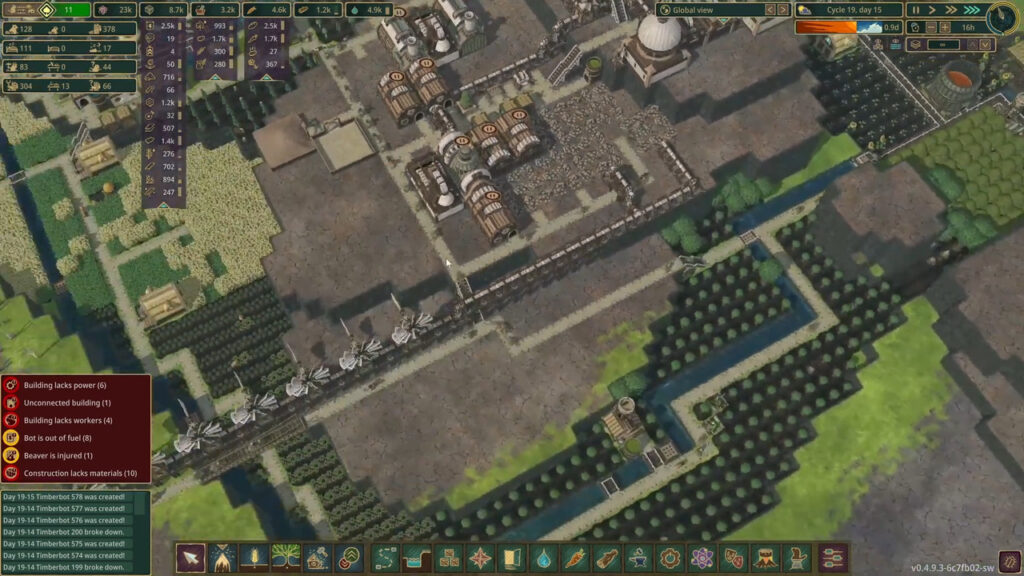
Developer: Mechanistry
Publisher: Mechanistry
Platform: PC
Tested on: PC
Timberborn – Preview
When we took a look at Stage Games Inc’s Early Access space base builder Desynced, we started our preview by reflecting on how building sims have been around for nearly six decades. There have of course been plenty of variations on the city-building genre, to the point that we’d imagine everything had already been done. Now, we’re not sure if there has ever been a city building sim about beavers before developer Mechanistry brought us Timberborn, but even if there was, we doubt it offers the same in-depth experience. Currently in its second year of Early Access and on its fourth update, Timberborn has already built up a thriving community that adores the beaver-themed city-building sim. While the full release of the game isn’t on the horizon just yet, we were eager to see how much content there already could be found in Timberborn.
You probably wouldn’t have guessed based on the Minecraft-like visuals, but Timberborn actually presents us with a post-apocalyptic narrative. Humanity has gone extinct, and water is scarce. The only way to survive in the barren wastelands is to adapt to the harsh environmental conditions. It’s time for beavers to do what they do best: build things out of wood, manipulate the flow of the remaining water, and establish a new position at the top of the food chain. In Timberborn, players take charge of a beaver clan and must try to create a thriving empire made out of mostly wood.
Of course, a beaver utopia starts from humble beginnings, and you’ll need to start with simple necessities, such as food, protection from the elements, and a place where your beavers can rest. You’d be forgiven for thinking that these beavers would just build dams, but they’ve actually mastered the arts of machine crafting and using electricity. Things start out simple enough, and Timberborn helps new players find their footing through an excellent tutorial. You are also able to tweak and customize the game to your liking so that your efforts to build a wooden version of New York or Paris are as relaxed or stressful as you want. Much of Timberborn’s manual labor is automated so that you can focus on expanding, rather than having to micromanage everything. In fact, you never even take direct control of the beavers themselves!
There is more to Timberborn’s mechanics than just a city-building sim with a cozy woodland skin slapped on. Managing the availability and flow of water is an integral part of your success, as beavers are aquatic mammals after all, and droughts can really cut into your population. Fortunately, there is some rhyme and reason as to how and when droughts occur, as Timberborn doesn’t just have day and night mechanics, but follows a seasonal cycle as well. That said, droughts do become more serious as you progress, so stockpiling food and water remains essential throughout the game. In Timberborn, resource management isn’t just about city expansion but about survival as well.
In the current version of Timberborn, you can choose between two beaver clans, and we expect the final version of the game to offer additional ones. These two factions are the Folktails and the Iron Teeth, although you’ll need to unlock the latter faction by playing with the first. Each offers a different playstyle, with the Folktails taking a more laid-back approach and the Iron Teeth relying on industrial advancements to grind out buildings more efficiently. That makes it sound like the Iron Teeth would be the “better” faction, but in practice, they just offer a variation on the same mechanics. Having only two factions might make it seem like Timberborn is currently light on content, but there is already plenty here to keep you occupied for many hours, and the combination of a thriving community and an in-game map editor should ensure that you won’t run out of things to do until the full version releases. That’s without even getting into the various difficulty settings and customization options that ensure that no two playthroughs of Timberborn are ever the same.
Apart from more factions to experiment with, the main thing we’d want to see is a fleshed-out narrative campaign, perhaps with some sort of zoning conflict between the different beaver clans. There are twelve official maps present already but the game lacks a meaningful narrative connection between them. The game also doesn’t offer controller support, which we would expect to be added in the future, but this type of game is typically more suited to mouse and keyboard inputs anyway.
The idea of combining city construction with beavers is a stroke of brilliance in more ways than one. Seeing our beavers hard at work never fails to put a smile on our face, and although the simplistic visuals aren’t necessarily up there with some other city-building sims, they are more than adequate and fit with the game’s cozy atmosphere. Likewise, the folksy, orchestral music imbues Timberborn with a sense of tranquillity. However, the game also carries a cautionary tale. Its central themes revolve around natural disasters and survival against the elements. These themes aren’t forced down your throat as you try to figure out the most efficient placement of your food silos, but they are still present. In this regard, Timberborn isn’t just a cute little city-building sim, but also one with an important message.
Conclusion
After having spent some time with Timberborn, it’s easy to see how and why the game managed to build up an enthusiastic community, even while in Early Access. The game looks and sounds adorable, offers plenty of customization options, and adds an extra dimension to the city-building sim formula by making the player adapt to the extreme elements of nature. While there is still plenty of room for additional content, including more beaver factions, there is already plenty here to get your -pun intended- teeth stuck into.
1 Comment
Leave a Reply
You must be logged in to post a comment.









[…] the past, we’ve taken a look at management sims featuring sentient animals as well as ones where robots were in charge, but up until now, none of them were about robot […]